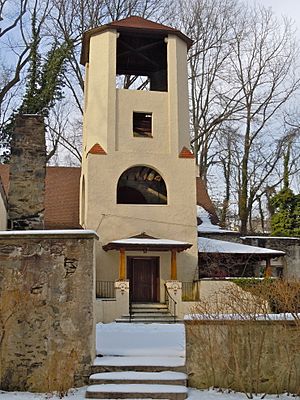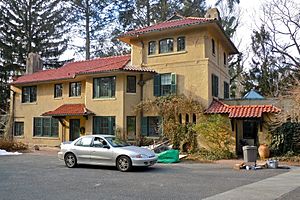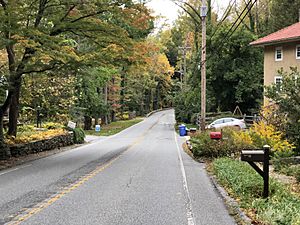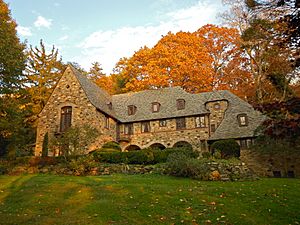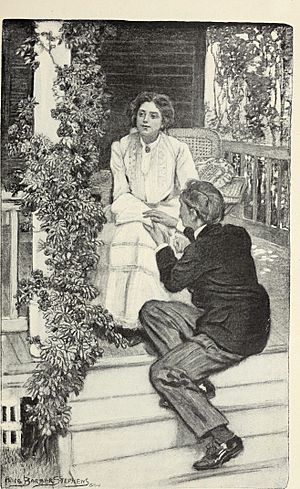Rose Valley, Pennsylvania facts for kids
Quick facts for kids
Rose Valley, Pennsylvania
|
|
|---|---|
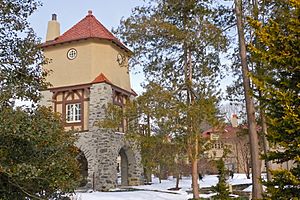
Water tower at Schoenhaus
|
|

Location in Delaware County and the U.S. state of Pennsylvania.
|
|
| Country | United States |
| State | Pennsylvania |
| County | Delaware |
| Area | |
| • Total | 0.73 sq mi (1.90 km2) |
| • Land | 0.73 sq mi (1.90 km2) |
| • Water | 0.00 sq mi (0.00 km2) |
| Elevation | 180 ft (50 m) |
| Population
(2020)
|
|
| • Total | 1,017 |
| • Density | 1,389.34/sq mi (536.57/km2) |
| Time zone | UTC-5 (EST) |
| • Summer (DST) | UTC-4 (EDT) |
| ZIP codes |
19063, 19086
|
| Area code(s) | 610 |
| FIPS code | 42-045-66192 |
| FIPS code | 42-66192 |
| GNIS feature ID | 1185459 |
| Website | |
|
Rose Valley Historic District
|
|
| Location | Roughly bounded by Ridley Creek, Woodward Rd, Providence and Brookhaven Rds and Todmorden Ln |
| Architect | William Lightfoot Price, others |
| Architectural style | Vernacular, Victorian, various |
| NRHP reference No. | 10000470 |
| Added to NRHP | July 19, 2010 |
Rose Valley is a small, historic town, called a borough, in Delaware County, Pennsylvania, United States. It covers about 0.73 square miles (1.9 square kilometers). In 2020, about 1,017 people lived there.
The area was first settled by Quaker farmers in 1682. Later, water mills along Ridley Creek helped power factories in the 1800s. In 1901, Rose Valley became a special community focused on the Arts and Crafts movement. This happened when architect William Lightfoot Price bought land around an old textile mill.
Price wanted to create a place where artists and craftspeople could live and work together. Even though the craft workshops eventually closed, Rose Valley left behind amazing buildings, beautiful natural areas, and a famous theater called the Hedgerow Theatre (started in 1923). Today, it's still a home for writers, painters, and architects. People say Rose Valley is a unique place where people are free to be themselves. The entire borough is so special that it was added to the National Register of Historic Places in 2010.
Contents
History of Rose Valley
Early Native American Life
Long ago, the Leni Lenape or Delaware tribe of Native Americans lived in the Rose Valley area. A very important trade route, called the Great Minquas Path, went right through where the borough is now. Along this path, Native Americans carried furs from the Susquehanna River to European traders on the Schuylkill and Delaware rivers.
First European Settlers
After William Penn received his land for the Colony of Pennsylvania, three brothers named Thomas, Robert, and Randall Vernon got land from Penn in 1682. They settled over 900 acres in what is now Rose Valley and Nether Providence Township. The brothers started farming the land, which was about 4 miles (6.4 km) north of Chester, then the biggest town in the colony.
Randall Vernon's house was built before 1700 and is still standing today. Robert Vernon might have built the house known as the "Bishop White House" around 1695. This house got its name because the family of Bishop William White used it during the yellow fever epidemic of 1793 in Philadelphia. Later, William Lightfoot Price changed this house after 1900, adding a stone porch and a red tile roof.
Revolutionary Times and the Underground Railroad
During the American Revolution, the Vernon family members were divided, with some fighting for America and others for the British. Many soldiers from the Revolution are buried in unmarked graves at the Old Union Methodist Church cemetery, the only church in Rose Valley. This church started around 1804, and its current building was built in 1835.
After the Revolution, some land was taken from a Vernon family member who supported the British. This land was sold to Jacob Benninghove, who built a large house there in 1787. He also built a dam on Ridley Creek and a water-powered snuff mill. Later, Samuel Bancroft bought the house in 1831 and named it Todmorden Mansion. He used secret tunnels and rooms in the house to help people escape slavery through the Underground Railroad.
Historic Mills of Rose Valley
Rose Valley was once home to at least three busy mills. One of the earliest mills was on Vernon Run, but only a small pond remains today.
Near the Bishop White House, along Ridley Creek, you can still see parts of a dam and a channel that led to the "Old Mill." This mill is now used as the town hall. It was likely built around 1789 as a snuff mill. From 1826 to 1850, it was a paper mill. Then, in 1861, it was rebuilt as a textile mill, but it burned down in 1885. After 1900, William Lightfoot Price built a furniture workshop on its old foundations. After another fire, it was rebuilt into the town hall we see today.
Another important mill was Hutton's Mill, built around 1840 as a feed mill. Later, it was used to make bobbins for the nearby textile mill and also as a warehouse. It even produced sandpaper at one point. William Lightfoot Price also rebuilt this mill into a meeting house and theater. After suffering fire damage, it was rebuilt again and now houses the famous Hedgerow Theatre.
The Arts and Crafts Community
Founding the Rose Valley Association
In July 1901, architect William Lightfoot Price led the creation of the Rose Valley Association. Their goal was to start a special community based on the ideas of the Arts and Crafts movement. This movement focused on handmade items and simple designs, often inspired by nature. The association bought about 80 acres of land, which became the heart of today's borough.
Price imagined a community where artists and craftspeople would have workshops and homes. He wanted to create a place where people could live and work together, making beautiful things by hand.
Life in the Arts and Crafts Community
Many people who joined or invested in Rose Valley were part of Price's discussion group, including famous figures like Edward Bok and brothers Samuel and Joseph Fels. Other early residents included Price's architectural partner, Hawley McLanahan, and artist Alice Barber Stephens. The community made decisions together in meetings called the "Folk Mote."
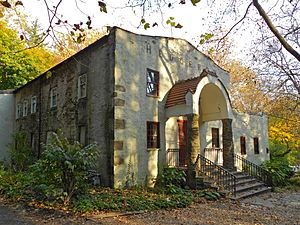
The Rose Valley Association didn't make crafts themselves. Instead, they rented out workshops to artists and provided them with homes, often designed or fixed up by Price. The crafts, like furniture, pottery, and handmade books, were sold from Price's office in Philadelphia. A journal called The Artsman was published from 1903 to 1907.
An art gallery was set up in the old bobbin mill, which was then called "Artsman's Hall." Starting in 1904, the well-known artist Alice Barber Stephens ran the gallery. She lived in the mill until Price turned a nearby barn into her house, Thunderbird Lodge. Artsman's Hall was also used for plays, with the first one performed on New Year's Eve, 1904. Eventually, this building became the permanent home of the Hedgerow Theatre, which is still active today.
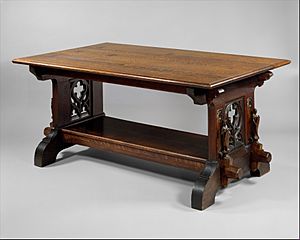
By 1910, the focus on craft production had lessened. Rose Valley became more of a commuter suburb for people working in Philadelphia, using the nearby Moylan - Rose Valley Station. The buildings designed or renovated by Price during this time are considered a major achievement for Rose Valley.
In 1926, a Pennsylvania State historic marker was placed on Rose Valley Road. It remembers the Great Minquas Path, an old Native American trail. The marker includes a sculpture of a beaver by Albert Laessle.
Geography and Location
Rose Valley is located in the middle of Delaware County, Pennsylvania. It is about 1.5 miles (2.4 km) south of Media, which is the county seat. It's also about 4 miles (6.4 km) north of Chester.
The borough is surrounded by Nether Providence Township to the north, east, and south. To the west, it borders Middletown Township. Ridley Creek, a stream that flows south into the Delaware River, forms the western edge of the borough.
Rose Valley has a humid subtropical climate. This means it has hot, humid summers and mild winters. Average temperatures range from about 32.6°F (0.3°C) in January to 77.6°F (25.3°C) in July.
Transportation in Rose Valley
As of 2008, Rose Valley had about 5 miles (8.0 km) of public roads. Most of these roads, about 3.72 miles (5.99 km), are taken care of by the borough itself. The remaining 1.30 miles (2.09 km) are maintained by the Pennsylvania Department of Transportation (PennDOT).
There are no major highways that go directly through Rose Valley. The main roads include Rose Valley Road, which runs from northwest to southeast through the center of the borough, and Brookhaven Road, which runs along the southeastern border.
Population and People
| Historical population | |||
|---|---|---|---|
| Census | Pop. | %± | |
| 1930 | 303 | — | |
| 1940 | 359 | 18.5% | |
| 1950 | 498 | 38.7% | |
| 1960 | 626 | 25.7% | |
| 1970 | 876 | 39.9% | |
| 1980 | 1,038 | 18.5% | |
| 1990 | 982 | −5.4% | |
| 2000 | 944 | −3.9% | |
| 2010 | 913 | −3.3% | |
| 2020 | 1,017 | 11.4% | |
In 2020, Rose Valley had a population of 1,017 people. The population density was about 1,389 people per square mile (536 people per square kilometer).
According to the 2010 Census, most residents were White (93.1%). There were also smaller percentages of African American (1.6%), Asian (2.8%), and people of two or more races (1.8%). About 2.1% of the population was Hispanic or Latino.
In 2000, there were 347 households in Rose Valley. About 34.9% of these households had children under 18 living with them. The average household size was 2.72 people. The median age in the borough was 46 years old.
The median income for a household in Rose Valley in 2000 was $114,373. This means half of the households earned more than this amount, and half earned less. The average income per person was $54,202. Only a small percentage of families (1.7%) and people (2.4%) lived below the poverty line.
Education
Students in Rose Valley attend schools in the Wallingford-Swarthmore School District.
- Younger students (grades K-5) go to Nether Providence Elementary School or Wallingford Elementary School.
- Middle school students (grades 6-8) attend Strath Haven Middle School.
- High school students (grades 9-12) go to Strath Haven High School.
Notable People from Rose Valley
Many talented people have lived in Rose Valley, including:
- Elenore Plaisted Abbott: A nationally known illustrator, designer, and artist.
- C. Yarnall Abbott: A photographer and author, and husband of Elenore Abbott.
- F. Townsend Morgan: An artist who worked for the WPA (Works Progress Administration).
- Margaret Scott Oliver: An actress and playwright.
- William L. Price: The architect who founded the Arts and Crafts community in Rose Valley.
- Alice Barber Stephens: A famous artist who lived and worked in Rose Valley.
- Horace Traubel: A poet and a close friend of the famous poet Walt Whitman.
Images for kids
-
Bishop White House, built around 1695
-
Thunderbird Lodge in Rose Valley.
See also
 In Spanish: Rose Valley para niños
In Spanish: Rose Valley para niños




